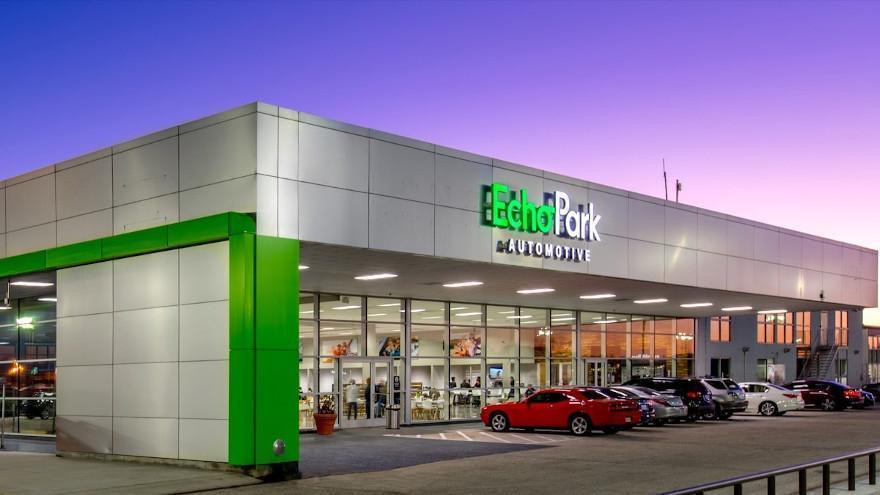Why Sonic expanded EchoPark’s age eligibility

File photo of EchoPark location. Photo credit: Sonic Automotive
By subscribing, you agree to receive communications from Auto Remarketing and our partners in accordance with our Privacy Policy. We may share your information with select partners and sponsors who may contact you about their products and services. You may unsubscribe at any time.
Within Sonic Automotive’s EchoPark used-car store program, second-quarter revenues hit $665.6 million, an all-time high and a 12% year-over-year increase.
On the other hand, EchoPark retail used-vehicle unit sales volume of 16,608 was down 22% year-over-year.
During the Q&A portion of the retailer’s earnings call, participants asked about the EchoPark performance and how much of the unit softness was due to demand in the current environment versus lack of supply.
Sonic president Jeff Dyke said, “the demand is there”, but they had to move beyond 1- to 4-year-old vehicles to fill EchoPark inventory as they are “just really hard to get.” That’s why the company announced in the first quarter it would be expanding its used search to include 5-plus-year-old vehicles.
Sonic has deliberately expanded its inventory offerings to include 5-plus-year-old vehicles, “which enables us to reach additional customer segments, improves consumer affordability and allows us to source more vehicles from non-auction sources, benefiting profitability,” he said.
Although the company is having what Dyke calls “great results” from the effort, he noted it may take four to five months to fully bring those vehicles into the fold.
Subscribe to Auto Remarketing to stay informed and stay ahead.
By subscribing, you agree to receive communications from Auto Remarketing and our partners in accordance with our Privacy Policy. We may share your information with select partners and sponsors who may contact you about their products and services. You may unsubscribe at any time.
EchoPark retail used-vehicle unit sale volume consisted of 91% 1 to 4-year-old vehicles and 9% 5-plus-year old vehicles.
But in the company’s Houston market, for example, Dyke said 32% of the used vehicles sold were in the 5-plus age range.
“So, the demand is there, but the demand is not there for a $640 monthly payment for pre-owned. That's what you're getting, and you're selling a 1- to 4-year-old car right now at $30,000, $31,000,” said Dyke. “So, retooling to the 5-year-old-plus cars, we're able to get that monthly payment back down into the $400 range, which is historically where it needs to be.”
Company leadership makes it clear that the shift in inventory focus is temporary, and the 1- to 4-year-old units are preferred.
“We think as inventory comes back, it doesn't mean that we won't sell the 5-plus year vehicles, but it just won't be as big a percentage of the mix as it is going to be right now while we work our way through this inventory time,” Sonic chief executive David Smith said.
The biggest concern today, according to Sonic leadership, is the availability of inventory. To combat that fact, Dyke said Sonic is procuring much more as a percentage of its used inventory off the street and through trade-ins, versus buying wholesale from auction. It was a really low number in the previous years, Dyke said; now that number is over 50%.
“So, (we’re) not concerned at all about pre-owned demand,” Dyke said.
And although used sales are down, profitability is higher. How much of this is due to non-auction sourced volume? And how sustainable is this when prices return to normal and negative equity once again becomes a concern with trade-ins?
This will make it harder to buy consumers “out of a vehicle” without attaching a sale to it.
“When that happens, you’re just back to the traditional used-car model, and we’ll see 1- to 4-year-old cars drop in valuation and price, and then we’re back to buying these vehicles, from both the auction and off the street … And that will bring the volume back from an EchoPark perspective in this category,” Smith said.
Smith expects the average value of vehicles in the 1- to 4-year-old segment to eventually drop back down to below $25,00 from the around $30,000 price tag they sit at today.
“That makes a big deal, because your tenor back down into the $400 for a monthly payment for the consumer, and that is what we're looking for,” Smith said. “That's the big issue right now for everybody in pre-owned, as the monthly payments are too high in the wonderful category.”
Danny Wieland, vice president of investor relations at Sonic, touched on the potential for negative equity situations as used prices fall.
“You're going to be in a position where lessees are not buying out their leases at the end of the term as they are to date, which historically has been less than 10% of leases, and it's somewhere in the neighborhood of 50%, today,” he said. “So that would benefit both the 1- to 4-year-old vehicles coming back to auction, as well as on the franchise side.”
He calls this the “kind of the organic inventory sourcing that we're missing out on a lot, particularly in our BMW and Honda brands today.”
Smith also pointed out that Sonic continued the expansion of its used-only line of stores in Q2, opening three new EchoPark locations, including two new retail hub locations in Raleigh, N.C., and St. Louis. Smith said the dealer group is on track to reach 50% of the population with its EchoPark line by the end of this year and 90% coverage by 2025.
Dyke said, “During the second quarter, we further expanded EchoPark’s nationwide geographic and digital network, opening three new locations and completing the rollout of our proprietary, best-in-class ecommerce platform to 100% of our nationwide traffic at EchoPark.com.”
The new ecommerce platform made up 19% of EchoPark retail unit sales volume in Q2, ”allowing our guests to shop their way via a modern omnichannel purchase experience or a seamless end-to-end online transaction,” Dyke said.
“Going forward, we intend to continue EchoPark's expansion in a targeted strategic manner. With our current rate of expansion and the success of our new e-commerce platform, we remain very confident in EchoPark's long-term prospects once the used vehicle market eventually reverts to historical norms,” Smith.
Speaking in terms of the company in entirety, used revenue again hit a quarterly record of $3.7 billion, which is 9% higher than the same period last year.
This progress occurred despite “ongoing supply chain disruptions, rising inflation and higher interest rates,” Smith said.


